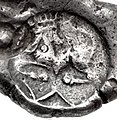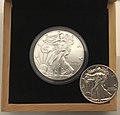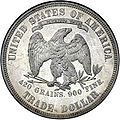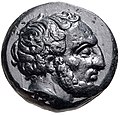The Numismatics Portal

Numismatics is the study or collection of currency, including coins, tokens, paper money, medals and related objects.
Specialists, known as numismatists, are often characterized as students or collectors of coins, but the discipline also includes the broader study of money and other means of payment used to resolve debts and exchange goods.
The earliest forms of money used by people are categorised by collectors as "odd and curious", but the use of other goods in barter exchange is excluded, even where used as a circulating currency (e.g., cigarettes or instant noodles in prison). As an example, the Kyrgyz people used horses as the principal currency unit, and gave small change in lambskins; the lambskins may be suitable for numismatic study, but the horses are not.[dubious ] Many objects have been used for centuries, such as cowry shells, precious metals, cocoa beans, large stones, and gems. (Full article...)
Selected article -
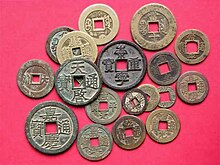
The cash or qian was a type of coin of China and the Sinosphere, used from the 4th century BC until the 20th century AD, characterised by their round outer shape and a square center hole (Chinese: 方穿; pinyin: fāng chuān; Jyutping: fong1 cyun1; Pe̍h-ōe-jī: hong-chhoan). Originally cast during the Warring States period, these coins continued to be used for the entirety of Imperial China. The last Chinese cash coins were cast in the first year of the Republic of China. Generally most cash coins were made from copper or bronze alloys, with iron, lead, and zinc coins occasionally used less often throughout Chinese history. Rare silver and gold cash coins were also produced. During most of their production, cash coins were cast, but during the late Qing dynasty, machine-struck cash coins began to be made. As the cash coins produced over Chinese history were similar, thousand year old cash coins produced during the Northern Song dynasty continued to circulate as valid currency well into the early twentieth century.
In the modern era, these coins are considered to be Chinese “good luck coins”; they are hung on strings and round the necks of children, or over the beds of sick people. They hold a place in various traditional Chinese techniques, such as Yijing divination, as well as traditional Chinese medicine, and feng shui. Currencies based on the Chinese cash coins include the Japanese mon, Korean mun, Ryukyuan mon, and Vietnamese văn. (Full article...)Selected image
Did you know...

- ...that with its two-dollar coin (reverse pictured), Newfoundland was the only British colony to issue circulating gold coinage?
- ...that Mount Burgess is nicknamed the Ten Dollar Mountain because it was featured on Canadian currency?
- ...that the American Buffalo gold bullion coin was the first .9999 fine 24-carat gold coin released by the United States Mint?
- ...that the Alabama centennial half dollar was the first commemorative coin minted with the image of a living individual?
- ...that Aksumite currency was the only native coinage to be issued in Africa without direct influence by an outside culture like Roman, Greek, etc...?
Related portals
Selected coin -
The Malaysian Kijang Emas is the official gold bullion coin of Malaysia and is minted by the Royal Mint of Malaysia. It was first issued on 17 July 2001. Malaysia is the 12th country in the world to issue its own gold bullion coin.
The Kijang Emas has a gold purity of 999.9 millesimal fineness or 24 karat. The coins come in denominations of RM200, RM100 and RM50 which are nominal face values, and weighs 1 oz, ½ oz and ¼ oz respectively. RM is the notation for the Malaysian ringgit. (Full article...)Selected banknote image -
General images -
Numismatic terminology
- Bullion – Precious metals (platinum, gold and silver) in the form of bars, ingots or plate.
- Error – Usually a mis-made coin not intended for circulation, but can also refer to an engraving or die-cutting error not discovered until the coins are released to circulation. This may result is two or more varieties of the coin in the same year.
- Exonumia – The study of coin-like objects such as token coins and medals, and other items used in place of legal currency or for commemoration.
- Fineness – Purity of precious metal content expressed in terms of one thousand parts. 90% is expressed as .900 fine.
- Notaphily – The study of paper money or banknotes.
- Scripophily – The study and collection of stocks and Bonds.
WikiProjects
Numismatic topics
Money - Coins - Banknotes - Electronic money - Exchange rate - Legal tender - Clubs - Terminology
Ancient currency: Asia - Byzantium - Greece - Primitive Money - Roman - Indian coinage
Modern currency: Africa - The Americas - Asia and the Pacific - Europe - Bullion coins - Challenge coin - Commemorative coins - Token coins
Economics: Banking - Bonds - Cheques - Credit Cards - Fiat currency - Gold standard - Mints - Monetary union - Reserve currency - Stocks
Production: Coining (machining) - Designers - Die making - Mint (coin) • Coinage Metals: Aluminum - Bronze - Copper - Gold - Platinum - Silver - Tin
Subcategories
Most traded currencies
| Rank | Currency | ISO 4217 code |
Symbol or abbreviation |
Proportion of daily volume | Change (2019–2022) | |
|---|---|---|---|---|---|---|
| April 2019 | April 2022 | |||||
| 1 | U.S. dollar | USD | US$ | 88.3% | 88.5% | |
| 2 | Euro | EUR | € | 32.3% | 30.5% | |
| 3 | Japanese yen | JPY | ¥ / 円 | 16.8% | 16.7% | |
| 4 | Sterling | GBP | £ | 12.8% | 12.9% | |
| 5 | Renminbi | CNY | ¥ / 元 | 4.3% | 7.0% | |
| 6 | Australian dollar | AUD | A$ | 6.8% | 6.4% | |
| 7 | Canadian dollar | CAD | C$ | 5.0% | 6.2% | |
| 8 | Swiss franc | CHF | CHF | 4.9% | 5.2% | |
| 9 | Hong Kong dollar | HKD | HK$ | 3.5% | 2.6% | |
| 10 | Singapore dollar | SGD | S$ | 1.8% | 2.4% | |
| 11 | Swedish krona | SEK | kr | 2.0% | 2.2% | |
| 12 | South Korean won | KRW | ₩ / 원 | 2.0% | 1.9% | |
| 13 | Norwegian krone | NOK | kr | 1.8% | 1.7% | |
| 14 | New Zealand dollar | NZD | NZ$ | 2.1% | 1.7% | |
| 15 | Indian rupee | INR | ₹ | 1.7% | 1.6% | |
| 16 | Mexican peso | MXN | MX$ | 1.7% | 1.5% | |
| 17 | New Taiwan dollar | TWD | NT$ | 0.9% | 1.1% | |
| 18 | South African rand | ZAR | R | 1.1% | 1.0% | |
| 19 | Brazilian real | BRL | R$ | 1.1% | 0.9% | |
| 20 | Danish krone | DKK | kr | 0.6% | 0.7% | |
| 21 | Polish złoty | PLN | zł | 0.6% | 0.7% | |
| 22 | Thai baht | THB | ฿ | 0.5% | 0.4% | |
| 23 | Israeli new shekel | ILS | ₪ | 0.3% | 0.4% | |
| 24 | Indonesian rupiah | IDR | Rp | 0.4% | 0.4% | |
| 25 | Czech koruna | CZK | Kč | 0.4% | 0.4% | |
| 26 | UAE dirham | AED | د.إ | 0.2% | 0.4% | |
| 27 | Turkish lira | TRY | ₺ | 1.1% | 0.4% | |
| 28 | Hungarian forint | HUF | Ft | 0.4% | 0.3% | |
| 29 | Chilean peso | CLP | CLP$ | 0.3% | 0.3% | |
| 30 | Saudi riyal | SAR | ﷼ | 0.2% | 0.2% | |
| 31 | Philippine peso | PHP | ₱ | 0.3% | 0.2% | |
| 32 | Malaysian ringgit | MYR | RM | 0.2% | 0.2% | |
| 33 | Colombian peso | COP | COL$ | 0.2% | 0.2% | |
| 34 | Russian ruble | RUB | ₽ | 1.1% | 0.2% | |
| 35 | Romanian leu | RON | L | 0.1% | 0.1% | |
| 36 | Peruvian sol | PEN | S/ | 0.1% | 0.1% | |
| 37 | Bahraini dinar | BHD | .د.ب | 0.0% | 0.0% | |
| 38 | Bulgarian lev | BGN | BGN | 0.0% | 0.0% | |
| 39 | Argentine peso | ARS | ARG$ | 0.1% | 0.0% | |
| … | Other | 1.8% | 2.3% | |||
| Total[a] | 200.0% | 200.0% | ||||
Web resources
- NumisWiki
- International Association of Professional Numismatists
- American Numismatic Association
- American Numismatic Society
- British Numismatic Association
- American Vecturist Association
- Challenge Coin Association
- Numismatic Museum of Athens, Greece
- The Perth Mint Australia
- Central Mint of China
- Royal Mint
- The French Mint
- United States Mint
- Bank of Russia
- Royal Canadian Mint
- Exact Change numismatic software
Things you can do
|
|
 |
Here are some tasks awaiting attention:
|
Associated Wikimedia
The following Wikimedia Foundation sister projects provide more on this subject:
-
 Commons
Commons
Free media repository -
 Wikibooks
Wikibooks
Free textbooks and manuals -
 Wikidata
Wikidata
Free knowledge base -
 Wikinews
Wikinews
Free-content news -
 Wikiquote
Wikiquote
Collection of quotations -
 Wikisource
Wikisource
Free-content library -
 Wikiversity
Wikiversity
Free learning tools -
 Wiktionary
Wiktionary
Dictionary and thesaurus
Sources
- ^ "Triennial Central Bank Survey Foreign exchange turnover in April 2022" (PDF). Bank for International Settlements. 27 October 2022. p. 12. Archived (PDF) from the original on 2022-10-27. Retrieved 2022-10-29.
- ^ The total sum is 200% because each currency trade is counted twice: once for the currency being bought and once for the one being sold. The percentages above represent the proportion of all trades involving a given currency, regardless of which side of the transaction it is on. For example, the US dollar is bought or sold in 88% of all currency trades, while the euro is bought or sold in 31% of all trades.








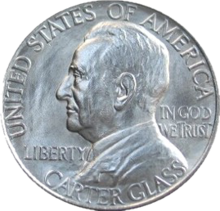
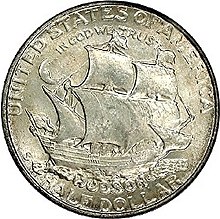

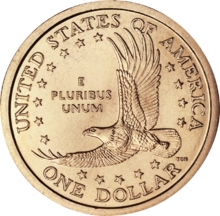

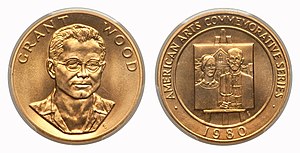
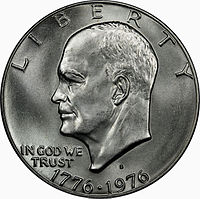

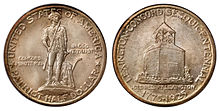




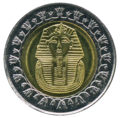















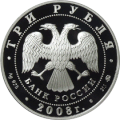


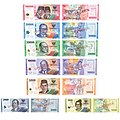







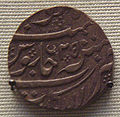









![Image 43Chinese round coins, Eastern Zhou dynasty – Warring States Period, c. 300–220 BC. Four Hua (四化, 30mm, 6.94 g). Legend Yi Si Hua ([City of] Yi Four Hua). (from Coin)](https://upload.wikimedia.org/wikipedia/commons/thumb/f/f9/CHINA%2C_Eastern_Zhou_dynasty_-_Warring_States_Period._State_of_Q%C3%AD._City_of_Yi._Circa_300-220_BC.jpg/120px-CHINA%2C_Eastern_Zhou_dynasty_-_Warring_States_Period._State_of_Q%C3%AD._City_of_Yi._Circa_300-220_BC.jpg)
